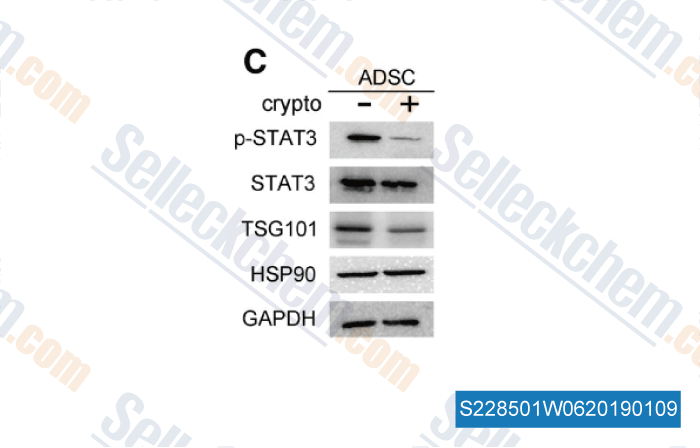|
Toll Free: (877) 796-6397 -- USA and Canada only -- |
Fax: +1-832-582-8590 Orders: +1-832-582-8158 |
Tech Support: +1-832-582-8158 Ext:3 Please provide your Order Number in the email. |
Technical Data
| Formula | C19H20O3 |
||||||
| Molecular Weight | 296.36 | CAS No. | 35825-57-1 | ||||
| Solubility (25°C)* | In vitro | Ethanol | 10 mg/mL (33.74 mM) | ||||
| DMSO | 8 mg/mL (26.99 mM) | ||||||
| Water | Insoluble | ||||||
| In vivo (Add solvents to the product individually and in order) |
|
||||||
|
* <1 mg/ml means slightly soluble or insoluble. * Please note that Selleck tests the solubility of all compounds in-house, and the actual solubility may differ slightly from published values. This is normal and is due to slight batch-to-batch variations. * Room temperature shipping (Stability testing shows this product can be shipped without any cooling measures.) |
|||||||
Preparing Stock Solutions
Biological Activity
| Description | Cryptotanshinone (Tanshinone C) is a STAT3 inhibitor with IC50 of 4.6 μM in a cell-free assay, strongly inhibits phosphorylation of STAT3 Tyr705, with a small effect on STAT3 Ser727, but none against STAT1 nor STAT5. Cryptotanshinone induces ROS-dependent autophagy and mitochondria-mediated apoptosis. | ||
|---|---|---|---|
| Targets |
|
||
| In vitro | Cryptotanshinone, a natural compound isolated from the roots of Salvia miltiorrhiza Bunge (Danshen), significantly inhibits STAT3-dependent luciferase activity, the STAT3 Tyr705 phosphorylation and the dimerization of STAT3, compared to tanshinone IIA which exhibits no activity. Cryptotanshinone (7 μM) dramatically blocks STAT3 Tyr705 phosphorylation but not STAT3 Ser727 phosphorylation in DU145 cells, and significantly inhibits JAK2 phosphorylation with IC50 of ~5 μM without affecting the phosphorylation of upstream kinases c-Src and EGFR, suggesting the inhibition of STAT3 Tyr705 phosphorylation might due to a direct mechanism probably by binding to the SH2 domain of STAT3. Cryptotanshinone significantly inhibits the proliferation of DU145 prostate cancer cells harboring constitutively active STAT3 with GI50 of 7 μM by blocking STAT3 activity, which leads to the down-regulation of cyclin D1, Bcl-xL, and survivin, subsequently the accumulation in the G0-G1 phase. Cryptotanshinone exhibits less growth inhibitory effect on PC3, LNCaP and MDA-MB-468 cells. [1] | ||
| In vivo | Cryptotanshinone administration significantly reduces the body weight and food intake of ob/ob mice (C57BL/6J-Lepob) and diet-induced obese (DIO) mice in a dose-dependent manner. Cryptotanshinone causes noticeably less fat in the adipose tissues, significant reductions of serum triglycerides and cholesterol levels, and 2.5- to 3-fold higher AMPK activity of the skeletal muscles than in the control mice. Oral administration of Cryptotanshinone at 600 mg/kg/day produces dramatic reductions in blood glucose levels of ob/ob mice (C57BL/6J-Lepob), db/db mice (C57BL/KsJ-Leprdb), and ZDF rats, which occur after 3 days and persist over the entirety of the monitoring period. [2] |
Protocol (from reference)
| Kinase Assay:[1] |
|
|---|---|
| Cell Assay:[1] |
|
| Animal Study:[2] |
|
References
|
Customer Product Validation

-
Data from [Data independently produced by , , Nat Commun, 2017, 8:14290]

-
Data from [Data independently produced by , , Diabetes, 2018, 67(2):235-247]

-
Data from [Data independently produced by , , Cancer Lett, 2018, 416:24-30]

-
Data from [Data independently produced by , , EBioMedicine, 2018, 36:358-366]
Selleck's Cryptotanshinone (Tanshinone C) has been cited by 73 publications
| PEDF peptide plus hyaluronic acid stimulates cartilage regeneration in osteoarthritis via STAT3-mediated chondrogenesis [ Bone Joint Res, 2024, 13(4):137-148] | PubMed: 38555936 |
| Revisiting the role of endogenous STAT3 in HPV-positive cervical cancer cells [ J Med Virol, 2023, 95(11):e29230] | PubMed: 38009614 |
| Galectin-9 Facilitates Epstein-Barr Virus Latent Infection and Lymphomagenesis in Human B Cells [ Microbiol Spectr, 2023, e0493222.] | PubMed: 36622166 |
| Inhibitory Effect and Mechanism of Ursolic Acid on Cisplatin-Induced Resistance and Stemness in Human Lung Cancer A549 Cells [ Evid Based Complement Alternat Med, 2023, 2023:1307323] | PubMed: 37089712 |
| Berbamine targets cancer stem cells and reverses cabazitaxel resistance via inhibiting IGF2BP1 and p-STAT3 in prostate cancer [ Prostate, 2023, 10.1002/pros.24632] | PubMed: 37828768 |
| Bile Acid-Microbiome Interaction Promotes Gastric Carcinogenesis [ Adv Sci (Weinh), 2022, e2200263] | PubMed: 35285172 |
| B7-H4 expression is upregulated by PKCδ activation and contributes to PKCδ-induced cell motility in colorectal cancer [ Cancer Cell Int, 2022, 22(1):147] | PubMed: 35410218 |
| The endosomal pH regulator NHE9 is a driver of stemness in glioblastoma [ PNAS Nexus, 2022, 1(1):pgac013] | PubMed: 35387234 |
| USP24-GSDMB complex promotes bladder cancer proliferation via activation of the STAT3 pathway [ Int J Biol Sci, 2021, 17(10):2417-2429] | PubMed: 34326684 |
| USP24-GSDMB complex promotes bladder cancer proliferation via activation of the STAT3 pathway [ Int J Biol Sci, 2021, 17(10):2417-2429] | PubMed: N/A |
RETURN POLICY
Selleck Chemical’s Unconditional Return Policy ensures a smooth online shopping experience for our customers. If you are in any way unsatisfied with your purchase, you may return any item(s) within 7 days of receiving it. In the event of product quality issues, either protocol related or product related problems, you may return any item(s) within 365 days from the original purchase date. Please follow the instructions below when returning products.
SHIPPING AND STORAGE
Selleck products are transported at room temperature. If you receive the product at room temperature, please rest assured, the Selleck Quality Inspection Department has conducted experiments to verify that the normal temperature placement of one month will not affect the biological activity of powder products. After collecting, please store the product according to the requirements described in the datasheet. Most Selleck products are stable under the recommended conditions.
NOT FOR HUMAN, VETERINARY DIAGNOSTIC OR THERAPEUTIC USE.
